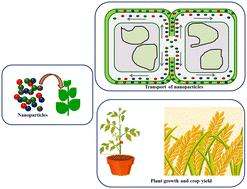当前位置:
X-MOL 学术
›
Environ. Sci.: Nano
›
论文详情
Our official English website, www.x-mol.net, welcomes your
feedback! (Note: you will need to create a separate account there.)
Nanomaterials for enhancing photosynthesis: interaction with plant photosystems and scope of nanobionics in agriculture
Environmental Science: Nano ( IF 5.8 ) Pub Date : 2022-08-05 , DOI: 10.1039/d2en00451h Chanchal Mony 1, 2 , Pawan Kaur 3 , James E. Rookes 2 , Damien L. Callahan 2 , S. V. Eswaran 1 , Wenrong Yang 2 , Palash Kumar Manna 1
Environmental Science: Nano ( IF 5.8 ) Pub Date : 2022-08-05 , DOI: 10.1039/d2en00451h Chanchal Mony 1, 2 , Pawan Kaur 3 , James E. Rookes 2 , Damien L. Callahan 2 , S. V. Eswaran 1 , Wenrong Yang 2 , Palash Kumar Manna 1
Affiliation

|
The complex process of photosynthesis requires precise arrangements of light harvesting molecules in the photosynthetic system. Artificial imitation of such reaction systems is difficult as they involve complex protein structures. Global population increase and the associated rise in demand for food have become a vital concern in the present and therefore it is essential to develop methods to improve agricultural yields, enhancing photosynthesis could be key to this. An approach is the use of self-assembling systems which are embedded into plants to enhance the activity of photo-functional pigments. This review discusses various nanoparticle mediated artificially embedded photosystems used to enhance photosynthesis. It also includes the mechanisms of interaction between nanoparticles and photosystem for enhancing photosynthesis due to the involvement of a light-harvesting function. The use of self-assembling systems to improve photosynthesis could increase productivity of plants, particularly in regions or seasons with low duration of sunlight. Plant nanobionics offers scope towards embedding nanostructures into plant systems and supplementing them with additional properties to enhance the efficiency of plants in terms of resistance to pathogens, adaptability to abiotic and biotic stresses, in addition to improving sunlight harnessing ability and energy conversion. This review also highlights the importance of functionalised nanoparticles with tunable structures to produce desirable properties. A mechanistic view of the nanoparticle interaction with plants will help us realise the potential and facilitate appropriate application of nanoparticles in plants for photosynthesis enhancement.
中文翻译:

用于增强光合作用的纳米材料:与植物光系统的相互作用以及纳米仿生学在农业中的应用范围
光合作用的复杂过程需要光合作用系统中光捕获分子的精确排列。这种反应系统的人工模仿是困难的,因为它们涉及复杂的蛋白质结构。全球人口增长和相关的粮食需求增长已成为当前的一个重要问题,因此必须开发提高农业产量的方法,增强光合作用可能是其中的关键。一种方法是使用嵌入植物中的自组装系统来增强光功能色素的活性。本综述讨论了用于增强光合作用的各种纳米粒子介导的人工嵌入光系统。它还包括纳米粒子和光系统之间的相互作用机制,以增强光合作用,因为涉及光捕获功能。使用自组装系统来改善光合作用可以提高植物的生产力,特别是在阳光持续时间短的地区或季节。植物纳米仿生学提供了将纳米结构嵌入植物系统并为其补充额外特性的空间,以提高植物在抵抗病原体、适应非生物和生物胁迫方面的效率,以及提高阳光利用能力和能量转换。这篇综述还强调了具有可调结构的功能化纳米粒子对产生理想性能的重要性。
更新日期:2022-08-05
中文翻译:

用于增强光合作用的纳米材料:与植物光系统的相互作用以及纳米仿生学在农业中的应用范围
光合作用的复杂过程需要光合作用系统中光捕获分子的精确排列。这种反应系统的人工模仿是困难的,因为它们涉及复杂的蛋白质结构。全球人口增长和相关的粮食需求增长已成为当前的一个重要问题,因此必须开发提高农业产量的方法,增强光合作用可能是其中的关键。一种方法是使用嵌入植物中的自组装系统来增强光功能色素的活性。本综述讨论了用于增强光合作用的各种纳米粒子介导的人工嵌入光系统。它还包括纳米粒子和光系统之间的相互作用机制,以增强光合作用,因为涉及光捕获功能。使用自组装系统来改善光合作用可以提高植物的生产力,特别是在阳光持续时间短的地区或季节。植物纳米仿生学提供了将纳米结构嵌入植物系统并为其补充额外特性的空间,以提高植物在抵抗病原体、适应非生物和生物胁迫方面的效率,以及提高阳光利用能力和能量转换。这篇综述还强调了具有可调结构的功能化纳米粒子对产生理想性能的重要性。











































 京公网安备 11010802027423号
京公网安备 11010802027423号